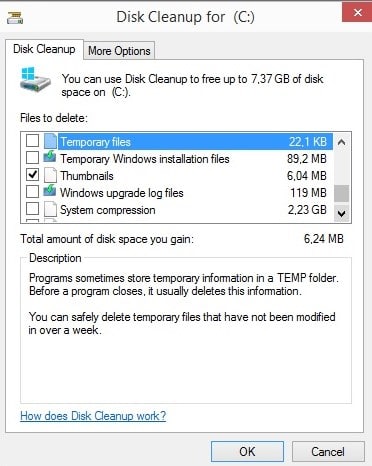

- #Compress your os drive disk cleanup how to
- #Compress your os drive disk cleanup upgrade
- #Compress your os drive disk cleanup windows 10
- #Compress your os drive disk cleanup zip
- #Compress your os drive disk cleanup download
#Compress your os drive disk cleanup windows 10
To enable Windows 10 NTFS compression for a folder, use these steps: You should use this option only if you do not have another option and have capable hardware. Important: Data compression can negatively impact system performance as it has to compress and decompress data on the fly. The feature can compress files, folders, or the entire drive.

#Compress your os drive disk cleanup zip
Windows 10 also includes a compression feature part of the NT File System (NTFS) to reduce the storage usage of current files maintaining normal access without the need to zip any content. Otherwise, you won't be able to launch the apps or play those games you moved to the new storage. The external drive must always be connected to the device when using this feature. Click the "Clean up system files" button.Īfter you complete the steps, you may need to repeat the same instructions to move additional apps or games to the new location.Use the "Drives" drop-down menu and select the (C:) drive (if applicable).Search for Disk Cleanup and select the top result to open the app.To use Disk Cleanup to delete temporary files on Windows 10, use these steps: You can still use the legacy Disk Cleanup tool to clear unnecessary files on Windows 10. Free up space deleting temporary files using Disk Cleanup on Windows 10 If you have multiple drives, under the "More storage settings" section, click the "View storage usage on other drives" option to open the page that lists all the drives on the device. For example, inside the "System & reserved" category, you will see how much space the installation, virtual memory, hibernation files, and system restore are using and how much space the system is reserving for updates. Once you complete the steps, you can determine the storage usage to focus on the locations to free up space. Select each category to see even more details and actions you can take to free up space on Windows 10.
#Compress your os drive disk cleanup download
You will still see your files, but their content will only download when you need them. When the device is running low on space, you can use it to make files only available in the cloud. Quick note: This option is part of OneDrive Files On-Demand that allows you to access your documents, pictures, videos, and other files using File Explorer without needing to sync them to reduce the space usage.Under the "Locally available cloud content" section, use the drop-down menu to specify how long OneDrive content synced to the device becomes online-only.The "Downloads" folder may contain valuable files you may have downloaded from the internet, which means that it is recommended to back up those files manually before running the feature. Quick tip: If you need to delete the most files, use the "1 day" option.
#Compress your os drive disk cleanup how to
Use the Downloads drop-down menu to specify how to clean up downloaded files.Use the Recycle Bin drop-down menu to specify how to clear already deleted files you do not need.Under the "Temporary Files" section, check the "Delete temporary files that my apps aren't using" option.Under the "Storage" section, click the "Configure Storage Sense or run it now" option.To enable Storage Sense on Windows 10, use these steps:
#Compress your os drive disk cleanup upgrade
Storage Sense is a feature that allows the deletion of different types of junk files (including previous installation files after an upgrade and temporary files) to free up space on all the drives to make room to store other files and improve drive efficiency.Īlthough you can use Storage Sense manually, you can also enable the feature to run maintenance automatically. Free up space removing junk files with Storage Sense on Windows 10 Remove files immediately when deleted" option if you want to delete the files from the drive skipping the Recycle Bin to minimize storage usage.Īfter you complete the steps, the Recycle Bin will be able to keep more or fewer files from a particular location, depending on your configuration. (Optional) Check the "Don't move files to the Recycle Bin.


 0 kommentar(er)
0 kommentar(er)
